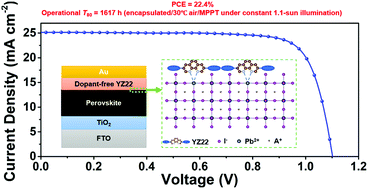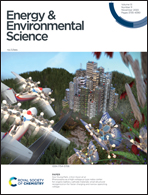A hole-transport material that also passivates perovskite surface defects for solar cells with improved efficiency and stability†
Abstract
While typical perovskite solar cells (PSCs) with doped Spiro-OMeTAD as a hole transport material (HTM) have shown rapid increase in their power-conversion efficiencies (PCEs), their poor stability remains a big concern as the dopants and additives used with Spiro-OMeTAD have a strong tendency to diffuse into and degrade the perovskite active layer under normal operating conditions. Aiming to push forward the development of PSCs, many dopant-free small-molecular HTMs have been reported based on energetic considerations for charge transfer and criteria for charge transport. However, the PCEs of the state-of-the-art PSCs with dopant-free small-molecular HTMs are still inferior to those using doped Spiro-OMeTAD, and little attention has been paid to the interactions between the HTM and perovskite absorber in PSCs. Here, we report a facile design concept to functionalize HTMs so that they can passivate perovskite surface defects and enable perovskite active layers with lower density of surface trap states and more efficient charge transfer to the hole transport layer. As a consequence, perovskite solar cells with a functionalized HTM exhibit a champion PCE of 22.4%, the highest value for PSCs using dopant-free small molecular HTMs to date, and substantively improved operational stability under continuous illumination. With a T80 of (1617 ± 7) h for encapsulated cells tested at 30 °C in air, the PSCs containing the functionalized HTM are among the most stable PSCs using dopant-free small-molecular HTMs. The effectiveness of our strategy is demonstrated in PSCs comprising both a state-of-the-art MA-free perovskite and MAPbI, a system having more surface defects, and implies the potential generality of our strategy for a broad class of perovskite systems, to further advance highly efficient and stable solar cells.



 Please wait while we load your content...
Please wait while we load your content...
